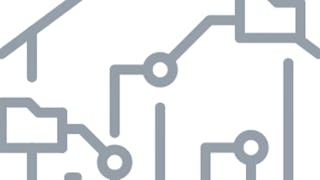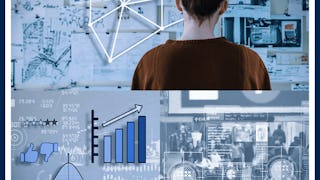This is the third of eight courses in the Google Advanced Data Analytics Certificate. In this course, you’ll learn how to find the story within data and tell that story in a compelling way. You'll discover how data professionals use storytelling to better understand their data and communicate key insights to teammates and stakeholders. You'll also practice exploratory data analysis and learn how to create effective data visualizations.


Go Beyond the Numbers: Translate Data into Insights
本课程是 Google Advanced Data Analytics 专业证书 的一部分

顶尖授课教师
80,819 人已注册
包含在  中
中
您将学到什么
Apply the exploratory data analysis (EDA) process
Explore the benefits of structuring and cleaning data
Investigate raw data using Python
Create data visualizations using Tableau
您将获得的技能
- Data Cleansing
- Data Transformation
- Tableau Software
- Data Manipulation
- Data Visualization
- Technical Communication
- Exploratory Data Analysis
- Data Processing
- Data Storytelling
- Data Quality
- Data Presentation
- Pandas (Python Package)
- Data Analysis
- Data Ethics
- Data Validation
- Data Visualization Software
- Python Programming
要了解的详细信息

添加到您的领英档案
21 项作业
了解顶级公司的员工如何掌握热门技能

积累 Data Analysis 领域的专业知识
- 向行业专家学习新概念
- 获得对主题或工具的基础理解
- 通过实践项目培养工作相关技能
- 通过 Google 获得可共享的职业证书

该课程共有5个模块
You’ll learn how to find the stories within data and share them with your audience. You’ll learn about the methods and benefits of data cleaning and how it can help you discover those stories. You’ll also go over the steps of the EDA process and learn how EDA can help you quickly understand data. Finally, you'll explore different ways to visualize data to communicate key insights.
涵盖的内容
8个视频5篇阅读材料3个作业2个插件
Finding stories in data using EDA is all about organizing and interpreting raw data. Python can help you do this quickly and effectively. You’ll learn how to use Python to perform the EDA practices of discovering and sculpting.
涵盖的内容
9个视频6篇阅读材料4个作业7个非评分实验室2个插件
You’ll explore three more EDA practices: cleaning, joining, and validating. You'll discover the importance of these practices for data analysis, and you’ll use Python to clean, validate, and join data.
涵盖的内容
11个视频6篇阅读材料5个作业5个非评分实验室2个插件
You’ll practice creating and presenting data stories in an ethical, accessible, and professional way. You'll also explore advanced data visualization techniques in Tableau.
涵盖的内容
8个视频11篇阅读材料5个作业2个插件
In this end-of-course project, you’ll practice using Python to perform EDA on a workplace scenario dataset. Then, you'll use Python and Tableau to visualize the data.
涵盖的内容
4个视频10篇阅读材料4个作业6个非评分实验室
获得职业证书
将此证书添加到您的 LinkedIn 个人资料、简历或履历中。在社交媒体和绩效考核中分享。
位教师

提供方
从 Data Analysis 浏览更多内容
 状态:免费试用
状态:免费试用 状态:免费试用
状态:免费试用 状态:免费试用
状态:免费试用 状态:免费试用
状态:免费试用University of Michigan
人们为什么选择 Coursera 来帮助自己实现职业发展




学生评论
854 条评论
- 5 stars
82.43%
- 4 stars
12.99%
- 3 stars
1.99%
- 2 stars
1.40%
- 1 star
1.17%
显示 3/854 个
已于 Feb 11, 2024审阅
Very well designed course for anyone having experience of any field willing to dive into data analytics.
已于 Aug 27, 2024审阅
Nice to learn about tools for analyzing data in python! It made my world of data analytics much bigger
已于 Jan 1, 2024审阅
There were voluminous amounts of detail with the data and projects to learn with.
常见问题
Organizations of all types and sizes have business processes that generate massive volumes of data. Every moment, all sorts of information gets created by computers, the internet, phones, texts, streaming video, photographs, sensors, and much more. In the global digital landscape, data is increasingly imprecise, chaotic, and unstructured. As the speed and variety of data increases exponentially, organizations are struggling to keep pace.
Data science and advanced data analytics are part of a field of study that uses raw data to create new ways of modeling and understanding the unknown. To gain insights, businesses rely on data professionals to acquire, organize, and interpret data, which helps inform internal projects and processes. Data scientists and advanced data analysts rely on a combination of critical skills, including statistics, scientific methods, data analysis, and artificial intelligence.
A data professional is a term used to describe any individual who works with data and/or has data skills. At a minimum, a data professional is capable of exploring, cleaning, selecting, analyzing, and visualizing data. They may also be comfortable with writing code and have some familiarity with the techniques used by statisticians and machine learning engineers, including building models, developing algorithmic thinking, and building machine learning models.
Data professionals are responsible for collecting, analyzing, and interpreting large amounts of data within a variety of different organizations. The role of a data professional is defined differently across companies. Generally speaking, data professionals possess technical and strategic capabilities that require more advanced analytical skills such as data manipulation, experimental design, predictive modeling, and machine learning. They perform a variety of tasks related to gathering, structuring, interpreting, monitoring, and reporting data in accessible formats, enabling stakeholders to understand and use data effectively. Ultimately, the work of data professionals helps organizations make informed, ethical decisions.
Large volumes of data — and the technology needed to manage and analyze it — are becoming increasingly accessible. Because of this, there has been a surge in career opportunities for people who can tell stories using data, such as senior data analysts and data scientists. These professionals collect, analyze, and interpret large amounts of data within a variety of different organizations. Their responsibilities require advanced analytical skills such as data manipulation, experimental design, predictive modeling, and machine learning.
更多问题
提供助学金,



